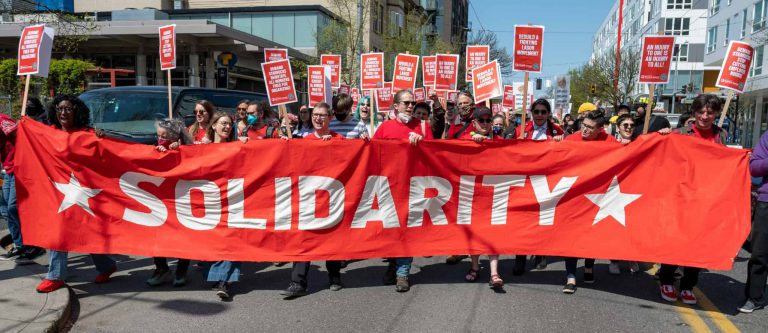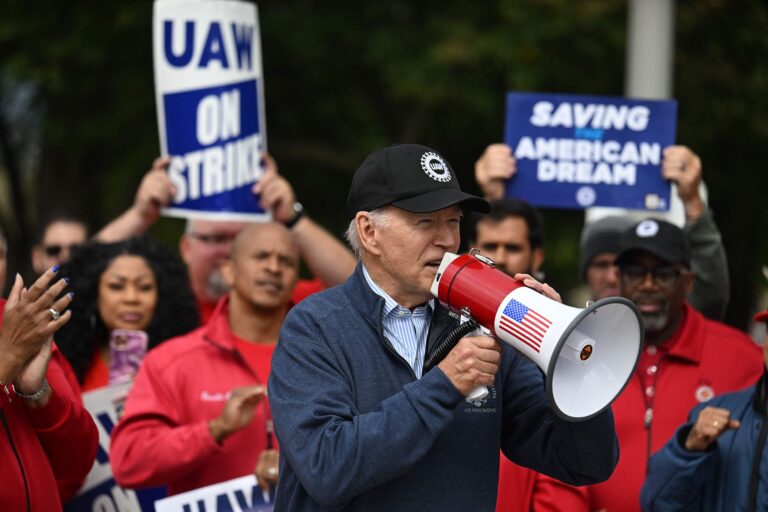Isabelle Holt is a student at Harvard Law School and a member of the Labor and Employment Lab.
The pandemic laid bare the vulnerability of the supply chain. Many American consumers who took for granted that products would end up on shelves or at their doorsteps, confronted for the first time the reality that the normally invisible supply chain consists of actual people, workers without whom the U.S. and global economies crumble.
The pandemic has driven a supply chain labor shortage. While supply chain workers include a broad swath of workers, transport workers, as the people who ensure products end up where they need to go, are a segment of supply-chain workers that wields particular power. After all, nothing moves without a transport worker. Transport workers include truck drivers, railroad workers, longshoremen, delivery drivers, seafarers, pilots, and warehouse workers who ensure goods are moved from one mode of transport to another.
While transport-worker visibility to both consumers and corporations may be relatively new because of the pandemic, supply chain organizing is not. And although there have been a number of unsuccessful transport worker strikes, successful transport worker strikes across sectors throughout history illustrate the potential power of modern transport worker organizing.
1934 Teamster and Longshoreman Strikes
From May 16 to August 21, 1934, Teamsters local 574 organized the first major U.S. trucking strike in Minneapolis. The strike aimed to unionize drivers and warehouse workers, regardless of industry, in opposition to an anti-union employer’s association. Police used violence against strikers — killing two and injuring more than sixty-five others — martial law was declared, military permits were issued to scab drivers, and the National Guard surrounded strike headquarters and arrested strike leaders. 40,000 strikers marched in response securing the release of the arrested leadership. The strike halted 95 percent of Minneapolis’s freight shipments and resulted in acceptance of strikers’ major demands and substantial pay increases for workers.
On May 9, 1934, longshoremen walked off the job in every West Coast port from San Diego to Juneau, when the International Longshoremen’s Association (ILA) started a strike that lasted for eighty-three days. What started as a longshoremen’s strike spread across the industry and was joined by other maritime transport workers such as mechanics, sailors, and pilots. In solidarity, the Teamsters refused to handle waterfront cargo. When politicians tried to reopen the port in San Francisco on July 5, a confrontation between workers and police, scabs, and National Guard troops led to the death of 2 striking longshoremen and the injury of 109 others. In response, on July 15, the San Francisco Labor Council declared a general strike and 150,000 San Francisco–area workers of every occupation walked off the job and subsequent general sympathy strikes in Portland and Seattle followed.
The 1934 longshoremen’s strike’s impact was broad. For example, in Seattle only a single ship managed to leave during the strike. The strike won a 30-hour work week, higher wages, union recognition, and a coast-wide contract for the longshoremen. Both the Teamster and ILA strikes of 1934 played a role in driving the Wagner Act towards adoption in 1935, leading to major protections for organized labor.
1966 International Association of Machinists Strike
On July 8, 1966, the International Association of Machinists called a strike that would last for 43 days, shutting down 60% of the U.S. commercial airline industry, over flat wages amidst huge corporate profits. The strike shut down five major airlines and workers picketed 230 airports from JFK to Honolulu. Ramp service workers, cleaners, storekeepers, inspectors, and food service workers joined machinists on the picket lines. While not joining in the strike directly, the Transport Workers Union stated that it would not perform any duties “not normally done prior to the strike” and its workers would not work on any aircraft leased from the five struck carriers. The strike won a 56-cent-an-hour raise for “skilled” workers and a 50-cent-an-hour raise for “unskilled” workers, a six percent raise on average, and led to a cost-of-living clause and substantial improvements in fringe benefits.
1979 Teamsters Strike
A 10-day Teamsters strike in 1979 was so powerful that it impacted the U.S. auto industry’s bottom line. The strike, called by rank-and-file union members, caused General Motors to lay off 12,400 workers to preserve profits and Chrysler to almost completely shut down. The strike won a 30% increase in wages and benefits for truck drivers and warehouse workers. At the peak of inflation, the new contract forced the Carter administration to “bend and stretch” its anti-inflation wage guidelines. The contract was ratified by an overwhelming 2-to-1 majority and then–president of the Teamsters, Frank E. Fitzsimmons stated that “this is the best national freight contract ever negotiated.”
1997 UPS Workers Strike
In August 1997, 185,000 UPS workers affiliated with the Teamsters struck for 15 days over the creation of a two-tier, part-time employment system. UPS had created a system where part-time workers did not receive benefits and were paid $9/hour, whereas full-time workers earned $19.95/hour with benefits. The success of the 1997 strike is attributed to its highly democratic nature. For over a year before contract negotiations were to begin, union leadership polled UPS workers about what their exact grievances were, collected thousands of signatures on petitions supporting these demands, and strategically framed the strike within the broader struggle against the rise of part-time work. This framing made the strike so publicly popular that then President Clinton refused to invoke the Taft-Hartley Act, which allows the president to seek a federal court injunction to block the continuation of the strike if it endangers national health or safety, despite pressure from both UPS and Wall Street. The UPS strike resulted in 10,000 part-time workers receiving full-time positions, raises for lower paid workers, and a 50% increase in pension funding.
Where Things Stand
Our modern economy still depends on people to move and unload products across the country. This gives transport workers structural power that if exercised collectively could lead to a modern labor revolution. This structural power is only potential, it must be actualized by successful organizing.
Today, the Teamsters have expanded organizing efforts to reach logistics companies, like XPO Logistics, with the goal of building a comprehensively unionized supply chain, from its first mile to its last. Seeking to capitalize on the window of increased supply chain labor engagement and visibility caused by the pandemic, the Teamsters filed a union election petition with the National Labor Relations Board in January on behalf of 250 XPO logistics truckers in Southern California who allege they are misclassified as independent contractors and are organizing XPO freight, warehouse and port workers.
The Teamsters are not alone in renewed transport worker organizing. Amazon workers at JFK8, a warehouse located on Staten Island, won their unionization vote, there is a looming dockworker strike by the International Longshore and Warehouse Union at key ports on the West Coast, and Alaska Airline pilots are currently on strike over stalled contract negotiations. While we are a long way from a fully unionized supply chain, past successful transport worker strikes show us that transport workers organized in solidarity with one another are immensely powerful. During a moment when transport workers are particularly visible to both corporations and the public, Teamsters international vice president Ron Herrera is right: “If there’s ever a time, right now is the most beneficial time” to push for increased transport worker rights.










Daily News & Commentary
Start your day with our roundup of the latest labor developments. See all
July 11
Regional director orders election without Board quorum; 9th Circuit pauses injunction on Executive Order; Driverless car legislation in Massachusetts
July 10
Wisconsin Supreme Court holds UW Health nurses are not covered by Wisconsin’s Labor Peace Act; a district judge denies the request to stay an injunction pending appeal; the NFLPA appeals an arbitration decision.
July 9
In Today’s News and Commentary, the Supreme Court green-lights mass firings of federal workers, the Agricultural Secretary suggests Medicaid recipients can replace deported farm workers, and DHS ends Temporary Protected Status for Hondurans and Nicaraguans. In an 8-1 emergency docket decision released yesterday afternoon, the Supreme Court lifted an injunction by U.S. District Judge Susan […]
July 8
In today’s news and commentary, Apple wins at the Fifth Circuit against the NLRB, Florida enacts a noncompete-friendly law, and complications with the No Tax on Tips in the Big Beautiful Bill. Apple won an appeal overturning a National Labor Relations Board (NLRB) decision that the company violated labor law by coercively questioning an employee […]
July 7
LA economy deals with fallout from ICE raids; a new appeal challenges the NCAA antitrust settlement; and the EPA places dissenting employees on leave.
July 6
Municipal workers in Philadelphia continue to strike; Zohran Mamdani collects union endorsements; UFCW grocery workers in California and Colorado reach tentative agreements.